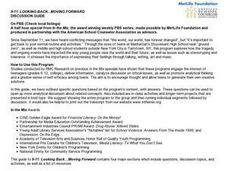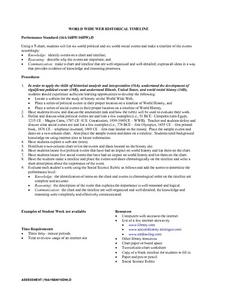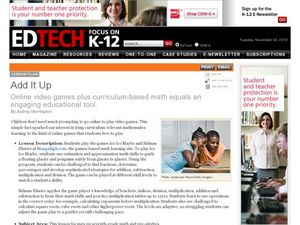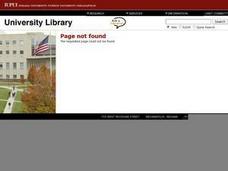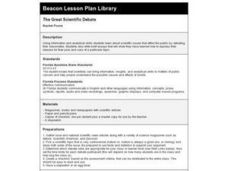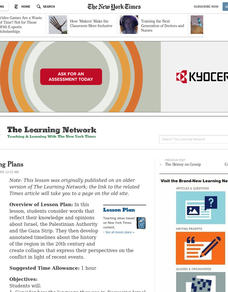Curated OER
Thoughts to the President
Students write a persuassive paragraph to the President stating their opinion on a topic. To do this, they start the message with a topic sentence such as "War is _____." The blank should contain a word or phrase expressing the student's...
Curated OER
9-11: Looking Back...Moving Forward
Students watch and discuss a video about teens living in and around New York and how 9-11 changed their lives. They answer discussion questions, read and discuss newspaper/magazine articles, take a self-test on depression, and create a...
Curated OER
World Wide Web Historical Timeline
Students use newspapers and magazines to identify six recent political and social events from around the world. In groups, they use a timeline template to place the events on the timeline in chronological order. They share with the...
Curated OER
The First Amendment, What it Means and When Libel Comes in to Play
Students research three topics: The First Amendment, John Peter Zenger and his trial, and libel. In this journalism and libel lesson, students discuss things authority figures have done they disagree with and the anit-sedition law....
Curated OER
Online video games plus curriculum-based math equals an engaging educational tool.
Seventh graders use online math games to practice understanding the skill of estimation and order of operations. In this lesson, 7th graders use the internet to play online games to strengthen their understanding of these skills.
Curated OER
Electronic Media
Students compare forms of electronic media. They watch a news broadcast and take notes on the content being conveyed. After viewing the broadcast, they read newspaper articles or news magazines to locate articles with similar content to...
Curated OER
Romare Bearden and the Face Collage
Fourth graders create a collage from magazines and newspapers to create a face. After finishing the face, they use mixed media to complete the background. They write their own description and examine the life and works of Romare Beardon.
Curated OER
German Fashion Show
Students explore traditional and modern German clothing items. After observing German folk costumes, students match vocabulary words to the pictures. They bring clothing for a fashion show, describe the clothing and express their...
Curated OER
The Great Scientific Debate
Fourth graders examine scientific issues that affect the public by debating their classmates. They also write brief essays that show they have learned how to express their reasons for their pros and cons of a particular topic.
Curated OER
Looking After Pets
Young scholars work in groups to compose their own "Duty of Care" for pets and make their own individual list from this discussion and illustrate it with drawing or images taken from magazines, websites or newspapers.
Curated OER
COLLAGE
Visual arts instructional activity featuring a self-representative collage that is constructed with magazine clippings that the student has selected.
Curated OER
Getting the Word Out: From Gutenberg's Press to Zines
Students examine the effects of Gutenberg's printing press on the world. Using this information, they create their own Zines or internet magazines about a social issue of their choice. They share their magazine with the class for...
Curated OER
War With Iraq
Students research a variety of magazine articles on the issue of Iraq and conflict resolution. Students chart the costs and benefits of the military action. Students prepare a rough layout and draft some content findings on the...
Curated OER
Creating your Frog's Environment
Students discuss where frogs can live. After the discussion, they create an environment for a frog using items of their choice. Some may include: construction paper, paint, magazines. The environment could even be 3-D. The key to this...
Curated OER
Consider the Issues
Students develop and express opinions on personal and societal issues in biology through journal entries (written and other forms), oral position statements and group discussions.
Curated OER
Types of Groups
Middle schoolers are introduced to the various types of groups in a society. In groups, they create a chart showing the similarities and differences between primary, secondary, and reference groups. Using magazines, they cut out...
Curated OER
Sculpture - Textures
Students distinguish between 2D and 3D elements in Escobar's work, explore assemblage, and identify the feelings expressed in Escobar's sculpture.
Curated OER
Hoops! There It Is!
Fifth graders view and discuss the use of voice in writing through the in-your-face, aggressive, powerful messages of the Nike advertisements and the book Hoops as examples of the intensity words can have and how voice is expressed. A...
Curated OER
Art and Patriotic Culture
Art forms, especially government-sponsored "poster art", very effectively conveyed specific cultural values during World War II. Understanding the role that visual images play in expressing issues and ideas is critical to developing...
Curated OER
Justice Served?
Students familiarize themselves with high-ranking Bush administration officials who have recently resigned and with various elements of political cartoons. THey research the role of the attorney general and the issues that surrounding...
Curated OER
Unsettling Plans
Pupils consider words that reflect their knowledge and opinions about Israel, Palestinian Authority and the Gaza Strip. They develop annotated timelines about the history of the region in the 20th century and create collages that express...
Curated OER
Media Literacy Skills
Third graders watch a news story from three different networks in order to determine how the same story can be presented in three different ways. Next, working in small groups they create a newscast of a current event to share with the...
Curated OER
Headline Poems
Students create poems using selected newspaper headlines, magazines, on-line publications etc. They choose headlines and compose their poems using their selected material. They add punctuation, photos and/or drawings as desired.
Curated OER
Social Studies: Grab Day at the Pueblo
Students develop a cultural understanding of "Grab Day." Using magazines, they clip out pictures to make collages of items thrown down to people on this day. Students label the items in their collages.

